MOHAWK WHISKEY PURE RYE
Mohawk Whiskey Pure Rye Indian Queen
25 September 2012 (R•090516)
“Keepers of the Eastern Door”
![]() We have so far in this series looked at the Brown’s Celebrated Indian Herb Bitters and the rather different, as far as mold, H. Pharazyn ‘Queen‘. Today we will look at the Mohawk Whiskey ‘Queen’ which is always found in shades of amber. Specimens of all three Queens are pictured above.
We have so far in this series looked at the Brown’s Celebrated Indian Herb Bitters and the rather different, as far as mold, H. Pharazyn ‘Queen‘. Today we will look at the Mohawk Whiskey ‘Queen’ which is always found in shades of amber. Specimens of all three Queens are pictured above.
You will immediately notice that the Pharazyn and Mohawk Queens are essentially the same mold with different typographic embossings. The difference from the Browns ‘Queen’ is obvious with right arm well below waist and sword in hand. The left arm is bent and holding a shield to the body. Lettering on the shield is Mohawk Whiskey Pure Rye. At shawl fringe, Patented Feb. 11, 1868. The Pharazyn ‘Queen’ has an unlettered shield. Area normally having patent date reads: “H. Pharazyn Philadelphia Right Secured”. Both of these queens have sheared mouths.
Mohawk (borrowed from the Narraganset ‘mohowaùuck’, ‘they eat (animate) things’ are the most easterly tribe of the Iroquois confederation. They call themselves Kanien’gehaga, people of the place of the flint. Kanien’kehá:ka (“People of the Place of Flint”) are an Iroquoian-speaking indigenous people of North America originally from the Mohawk Valley in upstate New York. Their territory ranged to present-day southern Quebec and eastern Ontario. Their current settlements include areas around Lake Ontario and the St Lawrence River in Canada. Their traditional homeland stretched southward of the Mohawk River, eastward to the Green Mountains of Vermont, westward to the border with the Oneida Nation’s traditional homeland territory, and northward to the St Lawrence River. As original members of the Iroquois League, or Haudenosaunee, the Mohawk were known as the “Keepers of the Eastern Door”. For hundreds of years, they guarded the Iroquois Confederation against invasion from that direction by tribes from the New England and lower New York areas. Mohawk religion is predominantly Animist. [Wikipedia]
Thayendanegea or Joseph Brant (March 1743 – 24 November 1807) was a Mohawk military and political leader, based in present-day New York, who was closely associated with Great Britain during and after the American Revolution. Perhaps the American Indian of his generation best known to the Americans and British, he met many of the most significant Anglo-American people of the age, including both George Washington and King George III. While not born into a hereditary leadership role within the Iroquois League, Brant rose to prominence due to his education, abilities and his connections to British officials. Through his sister, Molly Brant, and his later leadership, he was associated with Sir William Johnson, the influential British Superintendent of Indian Affairs in the province of New York. During the American Revolutionary War, Brant led Mohawk and colonial Loyalists against the rebels in a bitter partisan war on the New York frontier. He was accused by the Americans of committing atrocities and given the name “Monster Brant”, but the charges were later found to be false. After the war, he relocated with most of his people to Canada to the Six Nations Reserve, where he remained a prominent leader.
Read More: Looking closer at the Brown’s Celebrated Indian Herb Bitters
Read more: Amethyst Indian Queen Found in Seattle
Read More: H. Pharazyn Indian Queen – Philadelphia
Read More: E. Longs Indian Herb Bitters
Read More: The Indian Herb Bitters Prepared by Drs Dickerson & Stark
Read More: Why do we call the bottles the ‘Indian Queen?’
Read More: The Rubenesque Queens
Read More: Barrel series – Original Pocahontas Bitters
Mohawk Whiskey ‘Queen’ Examples
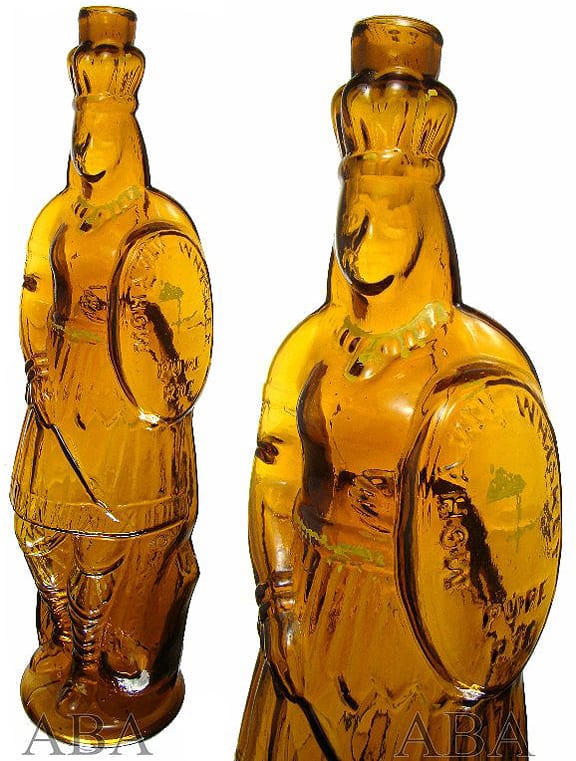
MOHAWK WHISKEY PURE RYE. Much like the Pharazyn, she looks like an Indian Queen holding a shield. In addition, this one has much of the original yellow paint, including a painted tomahawk on the shield (very important). We’d have to imagine they don’t come a lot better than this in both color and condition. This reads, “PAT FEB 11, 1868” on the reverse base area. Rolled lip is perfect. A terrific example of a rare and desirable figural whiskey. Ex Dr. Burton Spiller collection. – American Bottle Auctions
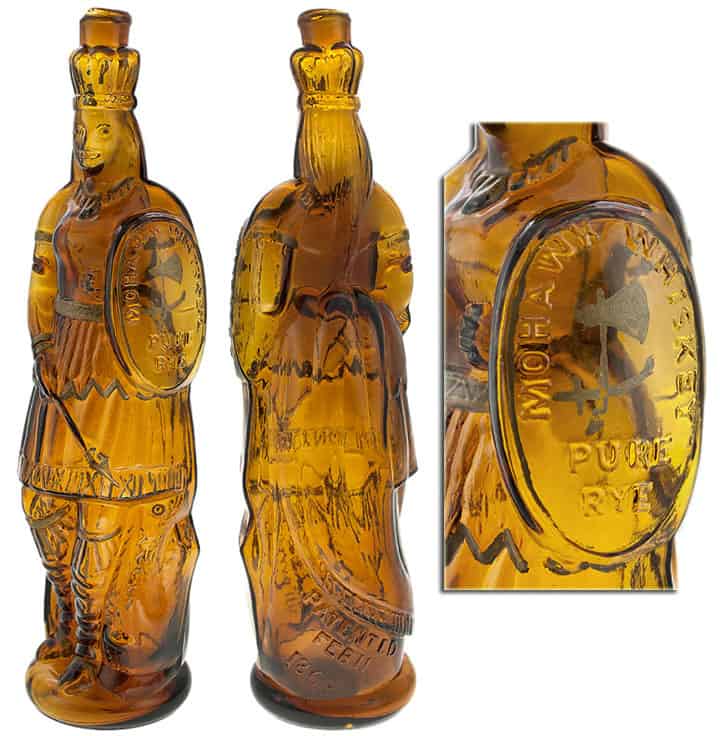
“MOHAWK WHISKEY / PURE / RYE – PATENTED / FEB. 11 / 1868”, (Denzin, MOH-11), American, ca. 1868 – 1875, medium yellowish amber Indian Queen, 12 3/8″h, smooth base, intact inward rolled lip, 90% of the original gold trim paint remains, perfect condition. One of only a very few with an undamaged lip, and the only one we’ve seen with this much of the original gold paint. In our opinion this is the ultimate example of this rarely offered and highly desirable bottle! – Glass Works Auction #97
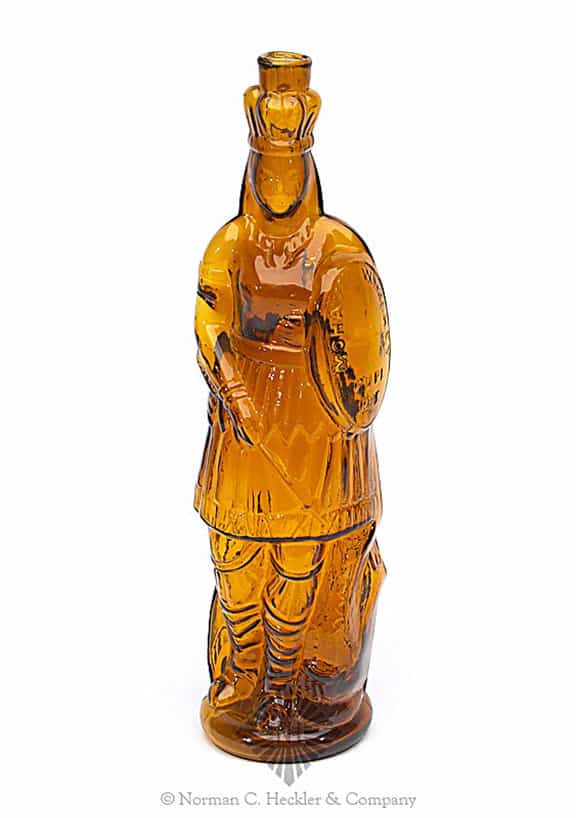
“Mohawk Whiskey / Pure / Rye / Patented / Feb. 11 / 1868” Figural Whiskey Bottle, America, 1860-1880. Indian maiden form, bright yellow amber, inward rolled mouth – smooth base, ht. 12 1/4 inches. H #2601 Detailed mold impression and beautiful bright color. Fine condition. – Heckler Auction 141

Carved Wooden Paint Decorated Figural Whiskey Bottle Prototype, America, 1860-1870. Indian maiden form, green, gold and red painted wood, ht. 12 inches; (minor blemishes). This form is similar to both the “H.P. Pharazyn” and the “Mohawk Whiskey Pure Rye” figural whiskey bottles. Extremely rare. Generally fine condition. – Heckler Auction 141

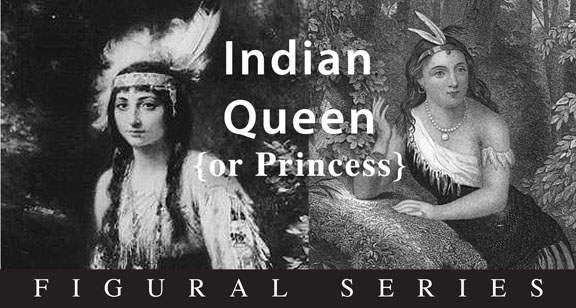
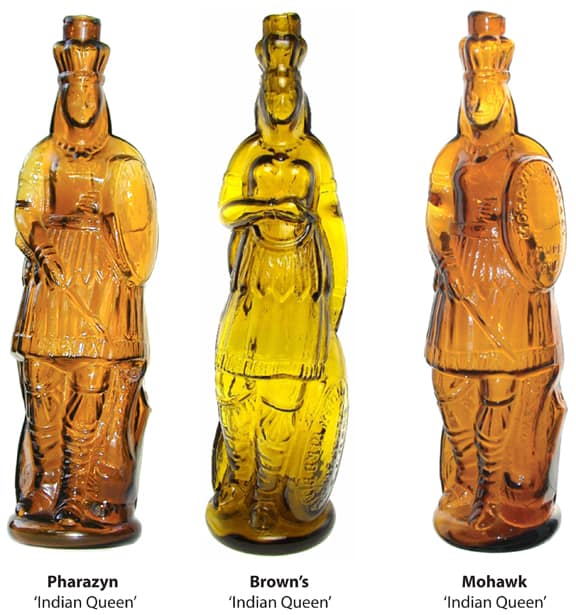
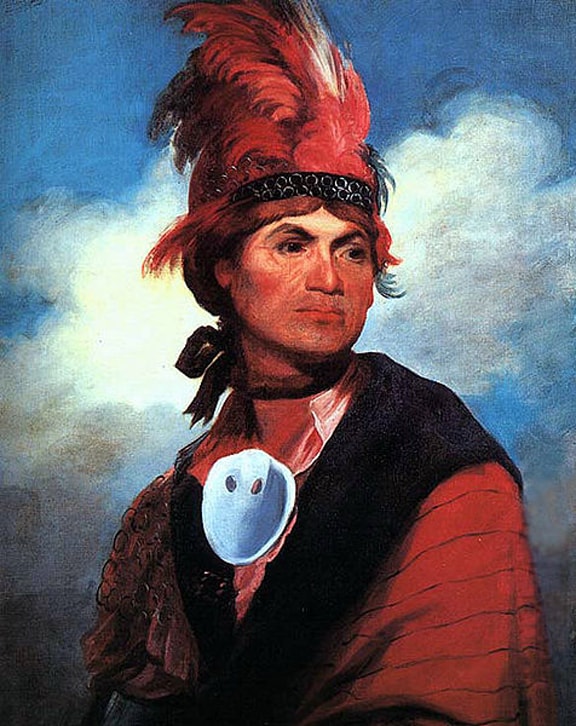
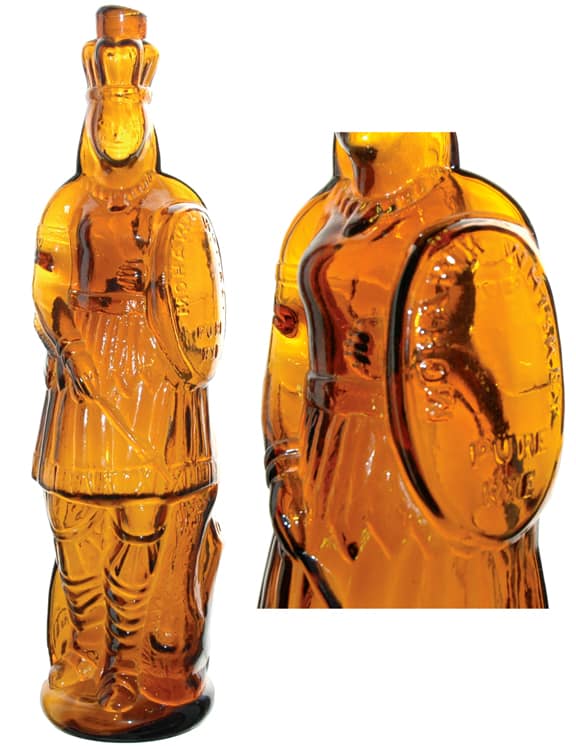
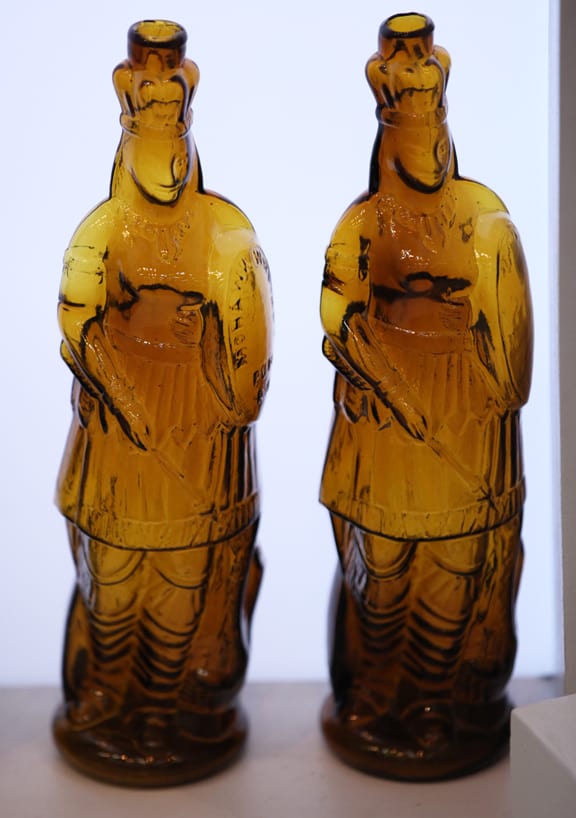






Added example from Glass Works Auction #97 “MOHAWK WHISKEY / PURE / RYE – PATENTED / FEB. 11 / 1868”, (Denzin, MOH-11), American, ca. 1868 – 1875, medium yellowish amber Indian Queen, 12 3/8″h, smooth base, intact inward rolled lip, 90% of the original gold trim paint remains, perfect condition. One of only a very few with an undamaged lip, and the only one we’ve seen with this much of the original gold paint. In our opinion this is the ultimate example of this rarely offered and highly desirable bottle!
Great looking “Queen”. These figural whiskeys are, in my opinion, still undervalued. Maybe I should trade-in my Bitters for a bunch of great, rare figural whiskeys and have cash left-over. Naaaa.